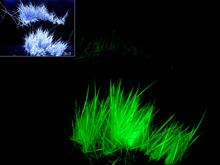Sleeping Beauty Goes Germline – A New Technology for Gene Transfer
Scientists at the Paul Ehrlich Institute report on an efficient method to move genes into the germline of experimental animals in three publications appearing in the current issue of Nature Protocols. The researchers have shown in mice, rats, rabbits and pigs that their method is safe, efficient and provides simple and flexible implementation to scientists.
Transgenic organisms are generated by transferring genes from one species to another. Transgenic animals are often used as models for inherited and acquired human diseases by academic and pharmaceutical research. In addition, transgenic animals are used as bioreactors to produce human proteins and as test systems for tissue and organ transplantation.
The research group of Dr. Zoltán Ivics, Head of the Division of Medical Biotechnology at the Paul Ehrlich Institute, teamed up with collaborators in Germany, Austria, Hungary, the Czech Republic and the USA to develop a method for efficient, safe and permanent gene transfer into the germline of mice, rats, rabbits and pigs. The method is based on the Sleeping Beauty transposon (a "jumping gene", see below) that consists of two components: a transgene unit to be integrated into the genome and the transposase enzyme that carries out integration of the transgene into the germline genome. The bi-component vector system is introduced into freshly fertilized eggs by microinjection, followed by transfer of the genetically modified zygotes into foster mothers. During transposition, the transposase cuts out the transgene unit from the transposon plasmid and inserts it into the egg’s genome. Because the transposase is only transiently present in the cell, the integrated transgene unit is stable and cannot change its position to other chromosomal locations.
The transposon-based gene transfer system combines the advantages of retroviral vectors (stable chromosomal insertion of transgenes) with those of naked DNA molecules (simple and safe production and application). The "cut-and-paste" transpositional mechanism allows for the incorporation of longer and more complex transgene constructs when compared to other methods. Another great advantage of this technology is that genetic mosaicism (not all cells of the developing transgenic organism contain the transgene) is significantly reduced. According to the researchers, this is due to rapid chromosomal insertion of the transgene in a narrow time-window following microinjection. "The Sleeping Beauty transposon system will greatly advance the spectrum of genetic modifications,"
explains Ivics the significance of the novel method. The previously developed technologies for germline transgenesis, including pronuclear injection of plasmid DNA, sperm-mediated gene transfer, intracytoplasmic sperm injection (ICSI) and injection of recombinant lentiviral vectors, all have their limitations ranging from low efficiency, genetic mosaicism, unwanted chromosomal modifications, a limited size of the transgenes to be transferred and cellular toxicity associated with the gene transfer procedures.
Background – The Sleeping Beauty transposon
 Fluorescent hair of a transgenic mouse following Sleeping Beauty gene transfer of a fluorescent marker gene
Source: Dr. W. Kues, Friedrich-Loeffler-Institut
Fluorescent hair of a transgenic mouse following Sleeping Beauty gene transfer of a fluorescent marker gene
Source: Dr. W. Kues, Friedrich-Loeffler-Institut
A transposon ("jumping gene") is a piece of DNA that can change its location in the genome through transposition. Genomic integration is the molecular basis of developing transposons as useful gene transfer vehicles. Sleeping Beauty is an artificial transposon that was reconstructed ("awakened") from >10 million year old transposon fossil sequences in fish genomes, and that was named after the Grimm brothers’ fairy tale. Sleeping Beauty was the first transposon that was demonstrated to be active in vertebrate cells.
Original publications
Ivics Z, Garrels W, Mátés L, Yau TY, Bashir S, Zidek V, Landa V, Geurts A, Pravenec M, Rülicke T, Kues WA, Izsvák Z (2014): Germline transgenesis in pigs by cytoplasmic microinjection of Sleeping Beauty transposons.
Nat Protoc 9: 810-827.
Online-Abstract
Ivics Z, Hiripi L, Hoffmann OI, Mátés L, Yau TY, Bashir S, Zidek V, Landa V, Geurts A, Pravenec M, Rülicke T, Bösze Z, Izsvák Z (2014): Germline transgenesis in rabbits by pronuclear microinjection of Sleeping Beauty transposons.
Nat Protoc 9: 794-809.
Online-Abstract
Ivics Z, Mátés L, Yau TY, Landa V, Zidek V, Bashir S, Hoffmann OI, Hiripi L, Garrels W, Kues WA, Bösze Z, Geurts A, Pravenec M, Rülicke T, Izsvák Z (2014): Germline transgenesis in rodents by pronuclear microinjection of Sleeping Beauty transposons.
Nat Protoc 9: 773-793.
Online-Abstract
Press Contact:
Paul-Ehrlich-Institut
Press Office
Dr. Susanne Stöcker, Dr. Corinna Volz-Zang, Brigitte Morgenroth
Paul-Ehrlich-Straße 51-59
63225 Langen
GERMANY
Telefon: +49 6103 77 1030
Telefax: +49 6103 77 1262
Email: presse@pei.de
The Paul-Ehrlich-Institut, the Federal Institute for Vaccines and Biomedicines, in Langen near Frankfurt/Main is a senior federal authority reporting to the Federal Ministry of Health (Bundesministerium für Gesundheit, BMG). It is responsible for the research, assessment, and marketing authorisation of biomedicines for human use and immunological veterinary medicinal products. Its remit also includes the authorisation of clinical trials and pharmacovigilance, i.e. recording and evaluation of potential adverse effects.
Other duties of the institute include official batch control, scientific advice and inspections. In-house experimental research in the field of biomedicines and life science form an indispensable basis for the manifold tasks performed at the institute.
The Paul-Ehrlich-Institut, with its roughly 800 members of staff, also has advisory functions nationally (federal government, federal states (Länder)), and internationally (World Health Organisation, European Medicines Agency, European Commission, Council of Europe etc.).
top



